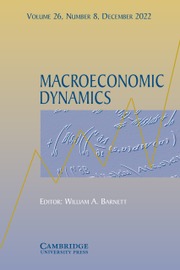No CrossRef data available.
Article contents
Auxiliary state method: theory and application
Published online by Cambridge University Press: 15 May 2025
Abstract
In this paper, I propose a new method called the auxiliary state method (ASM) for solving highly nonlinear dynamic stochastic general equilibrium (DSGE) models with state variables that exhibit a non-elliptical ergodic distribution. The ASM method effectively avoids most improbable states that, while never visited, can create issues for numerical methods. I then demonstrate the ASM method by applying it to a model with highly asymmetric nominal rigidities, which are necessary to match the skewness of the U.S. inflation distribution. The ASM method can handle the high level of asymmetry, whereas the standard projection method cannot. Additionally, the ASM method is significantly faster than the standard projection method.
Keywords
Information
- Type
- Articles
- Information
- Copyright
- © The Author(s), 2025. Published by Cambridge University Press

